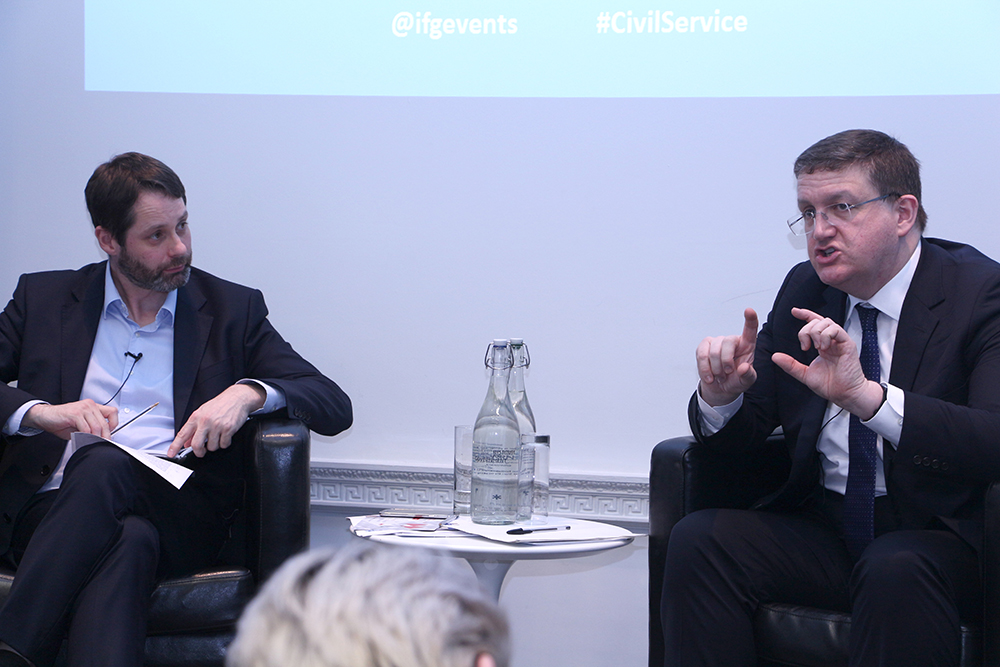Since Brexit, the question of whether the civil service has the right people, skills, and capabilities is the subject of heated debate. One man who must address these issues is Rupert McNeil, the head of Government HR, says Jen Gold.

Rupert McNeil, the Government’s Chief People Officer, set out his vision for the civil service workforce in a keynote speech at the IfG on Wednesday.
As well as heading up the civil service human resources (HR) function, McNeil provides leadership on talent management, capability, capacity, inclusion, and workplace culture. At a time when the Government faces a hugely challenging agenda, he certainly has his work cut out.
A demanding climate
The HR profession has a big role to play at a time when two new departments are getting up and running in response to Brexit, when budget reductions are triggering fresh redundancy rounds, and when public services are subject to major transformation programmes. All too often in the past, the HR function has at best been regarded as offering a transactional service – and at worst, a compliance exercise or an obstacle to be overcome. The Institute’s archive of exit interviews with former government ministers shows that this frustration sometimes goes right to the top.
Becoming more inclusive
McNeil acknowledged the need to get basic processes right but also the more strategic role that HR can, and should, be playing. He has made some early progress. One of his top priorities is recruiting the ‘best talent wherever it is found’. He wants the civil service to be ‘the most inclusive employer in the UK by 2020’ – a goal he first set out in his 2016 strategy document, the Civil Service Workforce Plan. This won’t be easy. Workforce data shows that BAME (Black, Asian and Minority Ethnic) civil servants are underrepresented at senior grades, and that staff engagement scores are much lower amongst civil servants with disabilities. Equally, a government-commissioned review of the service’s flagship graduate recruitment programme – the Fast Stream – found that the socio-economic background of applicants bore little resemblance to wider society, with those from more deprived backgrounds severely underrepresented.
But McNeil and his team have drafted in the Behavioural Insights Team to identify biases in the civil service’s recruitment practices, and have introduced a raft of measures to reform them. The most recent Fast Stream applicant data shows a 50% increase in candidates with lower socio-economic backgrounds in 2016 compared to 2015.
Designing clear career paths
But members of the audience pointed to other areas where HR could be doing so much more. One of those areas is the perennial problem of the Whitehall merry-go-round in job postings – a feature of Government that undermines the delivery of major projects, as the Institute has shown. Current pay and promotion structures simply don’t reward staying power. McNeil had no easy answers.
The 2020 inclusivity goal also includes ‘a greater diversity of practical experience’. For McNeil, the route to leadership positions at the top of the civil service should be as open to those on the frontline, from prison officers to Jobcentre work-coaches, as it is to those in traditional policy roles. The new drive for civil service professions to design clear career paths with structured progression opportunities should help. So too will a common approach to leadership – spearheaded by the new Leadership Academy – that will promote a broader understanding of civil service professions and functions.
Bringing outsiders on board
The civil service also needs to become a more ‘fluid and permeable place’, enabling greater movement between jobs in the public and private sectors. But for this to work, as Julian McCrae, IfG Deputy Director, pointed out, the civil service needs to do a much better job of integrating outsiders. It is now two years since Catherine Baxendale’s report for the Cabinet Office painted a fairly bleak picture of the induction process that confronts external recruits to senior positions. It’s far from clear that much has changed.
Precisely how the HR function will help enable the changes that McNeil set out remains to be seen. McNeil rightly characterised Whitehall’s functions (including HR) as ‘part of the glue that binds government together – providing expertise where it is needed, when it is needed’. If HR is to play its part, McNeil has work to do.
- Topic
- Brexit